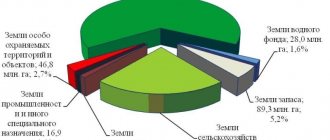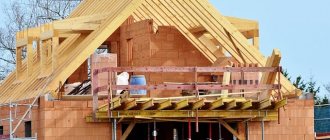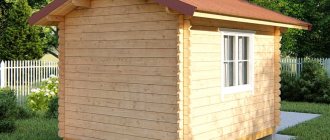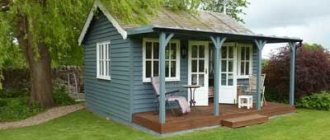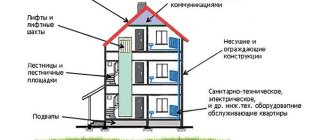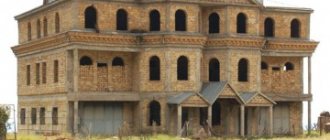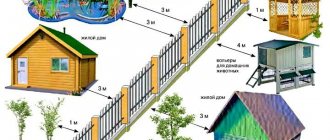The year 2019 began with the entry into force of legislative changes affecting all summer residents in Russia. Some of them are accepted by gardeners and gardeners with great enthusiasm, others raise doubts and concerns. But the most important thing that interests all summer residents is how a garden house differs from a residential building and how the introduction of new legal terms will affect their lives.
The concept of a residential and garden house and their differences. Residential building
217-FZ introduces a new concept of a garden plot of land - a plot of land intended for recreation of citizens and (or) cultivation by citizens for their own needs of agricultural crops with the right to place garden houses, residential buildings, outbuildings and garages (clause 1 of Article 3 217 -FZ).
At the same time, all land plots with such types of permitted use as “for gardening”, “for gardening”, as well as “dacha land”, “for dacha farming”, “for dacha construction” become equivalent and are recognized as garden land plots (clause 7 of article 54 217-FZ).
It follows from this that the owner of a garden plot of land has the right to place on the plot his choice: a garden house or a residential building.
Until 2021, gardeners were allowed to build only residential buildings on plots without the right of registration (registration), and therefore without the right to permanently reside in them.
With the entry into force of 217-FZ, buildings located on a garden plot, registered in the Unified State Register of Real Estate, as a “ residential building ”, “residential”, are recognized as residential buildings. Consequently, since residential buildings have been recognized as residential buildings, the owners have the right to register in them at their place of residence. At the same time, documents for residential buildings do not need to be reissued (clause 9 of Article 54 217-FZ).
The Town Planning Code of the Russian Federation also equalized the concepts of “individual housing construction object”, “residential building” and “individual residential building” (Clause 39, Article 1 of the Civil Code of the Russian Federation).
Unlike an individual residential building, a garden house is non-residential. The information contained in the extract from the Unified State Register of Real Estate about the purpose of buildings, such as “non-residential structure”, “non-residential” “seasonal use”, with the exception of outbuildings and garages, is recognized as garden houses (clause 11 of article 54 217-FZ).
Also, Article 16 of the Housing Code of the Russian Federation, which contains a list of types of residential premises, does not classify a garden house as residential.
A garden house is only a building for seasonal use, intended to satisfy citizens' household and other needs related to their temporary stay in such a building (clause 2 of article 3 of 217-FZ).
Therefore, you cannot register in garden houses.
Pros and cons of living and relaxing in the countryside
There are two types of country pastime:
- Permanent residence.
- Weekend trips for recreation.
They differ significantly both in the requirements for the purchased housing and in the cost of its arrangement. For permanent residence you need a permanent house, well insulated and connected to utilities. For short-term trips, a small building is enough - a “roof over your head”, in which you can wait out bad weather and hide from extreme heat. In this case, amenities are located in the yard, and the main achievement of civilization is a single-phase power line.
The advantages of a country holiday are known to everyone. This is silence, clean air, picturesque landscapes and natural products. For the sake of these benefits, you can put up with the Spartan life for a couple of days and even find some attractiveness in it. Anyone who wants to leave the noisy city for a long time cannot come to terms with a minimum of comfort.
A significant disadvantage of permanent residence outside the city is the large investment of time and money to maintain the house in a livable condition. If all the utility work in the city is poorly done, but carried out by the local DEZ, then on your site you will have to deal with the leaking roof, faulty sewage system and other housing engineering options yourself. Therefore, without practical experience, repair skills and accounting savvy, it is more profitable to buy not a large house, but a compact dacha for a temporary stay.
The area of the plot is another controversial selection factor. Houses in the village are sold together with a decent number of “acres” and you will have to somehow organize them. This is hard work and daily worries. The only way to curb nature is to sow lawn grass on your plot or grow a garden without burdening yourself with “garden gymnastics.”
The advantage of a large plot is the distance from neighbors, relations with whom many country homeowners have are far from ideal. The dacha is worse in this regard, since on 5 acres it is difficult to create a comfortable “gap” between neighboring houses. But there is less work on a compact area. Therefore, this option is chosen by those who are not attracted to a shovel and a hoe.
Construction of a residential building on a garden plot
According to Art. 1 of the Town Planning Code of the Russian Federation, an individual residential building has the following features:
- Detached building (i.e. not an annex)
- Number of ground floors – maximum 3;
- Height – up to 25 meters;
- Availability of rooms and auxiliary premises;
- Not intended for dividing into parts of a residential building.
The construction of a residential building on a garden plot does not differ from the construction on a land plot intended for individual housing construction, with the exception of the following points:
1. Territorial zone. According to paragraph 2 of Art. 23 217-FZ, the construction of capital construction projects on garden land plots is permitted only if such land plots are included in the territorial zones provided for by the rules of land use and development, in relation to which town planning regulations have been approved that establish the maximum parameters for such construction. For example, a garden plot of land is located in the territorial zone CX-1 - Gardening Zone, but the land use and development rules in this zone do not provide for the construction of capital construction projects, so it will not be possible to obtain permits for construction.
TIP: To find out in which territorial zone the land plot is located, you need to order an urban planning plan for the land plot (GPZU) from the local government - free of charge, period - 1 month. or an extract from the information system for supporting urban planning activities (extract from ISOGD) - usually for a fee (up to 1000 rubles), period - up to 1 week.
2. Extension of the dacha amnesty. Since August 2018, there is no requirement to obtain permission to build a residential building. Instead of a construction permit, it is necessary to receive a notification about the compliance of the planned facility and subsequently a notification about the compliance of the constructed facility with legal requirements.
But in connection with the extension of the second dacha amnesty until March 1, 2021 , owners can register existing houses in a simplified manner without sending a notification to the administration and complying with the requirements of the town planning regulations (Part 12 of Article 70 218-FZ). Cadastral registration and registration of ownership of a residential building will be carried out on the basis of a technical plan and declaration.
Moreover, until 03/01/2021, the verification of whether a building is residential or non-residential is determined by the cadastral engineer, and not by the local government.
After 03/01/2021, registration and registration of the house will be carried out in a notification manner, that is, through notifications about planned construction / about the completion of construction with a mandatory visit to the site by specialists from the administration.
Room
Yes, it’s unlikely that you’ll be able to buy a decent apartment. But there is another option - buying a room in a multi-room apartment. These types of transactions are becoming more and more popular in our real estate market.
Article on the topic
Feng Shui, zodiac and superstitions: how Russians choose an apartment True, even in this case you won’t be able to buy anything in Moscow. Within a million rubles, only part of the rights to a separate room are sold in the Russian capital, which is usually purchased only to obtain Moscow registration. And these deals are not considered a very reliable enterprise, much less a profitable purchase.
Rooms in the Moscow region are another matter. For a million you can easily find yourself a very decent room with an area of 12–17 square meters, sometimes even with a balcony or loggia, in such cities of the Moscow region as Voskresensk, Elektrostal, Klin, Sergiev Posad, Chekhov, Pushkino and even Ramenskoye. Many other cities located around Moscow are also taken into account, if you do not try to find something in the nearest Moscow region. Khimki or, say, Podolsk still remains beyond the reach of our million rubles.
In such a purchase, you can not only save money, but even make money if you can also find a tenant for the purchased room. Yes, the amount will not be prohibitive, because renting a room in the listed cities costs 10–12 thousand rubles. But, if the tenant lives in the room for at least a year, this is already 120-150 thousand rubles. So, in 8–10 years, the room will not only pay for itself, but will also bring benefits, and the square meters will still remain your property.
Economy class housing. Who in the Russian Federation can buy an apartment below market value?
More details
Conversion of a garden house into a residential building
The procedure for recognizing a garden house as a residential building is regulated by Decree of the Government of the Russian Federation dated January 28, 2006 No. 47 “On approval of the Regulations on the recognition of premises as residential premises...” (as amended on December 24, 2018) (hereinafter referred to as the Regulations).
Requirements for a residential building:
According to Art. 15 Housing Code of the Russian Federation, Art. 4 of the Regulations, residential premises are recognized as isolated premises, which are intended for the residence of citizens, are real estate and are suitable for living, meeting established sanitary and technical rules and regulations, and other legal requirements.
In other words, a residential building must:
- To be built on a foundation, i.e. have a strong connection with the earth;
- Be safe for the life and health of residents;
- Have electricity;
- Be provided with water supply;
- Have a sewerage system (septic tank);
- Be provided with heat supply.
Required documents:
- Application for recognition of a garden house as a residential building.
The application is written in free form with the obligatory indication of the following information:
- Full name of the applicant;
- Postal or email address of the applicant;
- Cadastral number of the land plot;
- Cadastral number of the garden house.
- Method of obtaining a decision from a local government body (in person, by mail, at the MFC).
Sample application:
- Extract from the USRN for a garden house. If the garden house is not registered, then the title document for the house (sale and purchase agreement, certificate of inheritance, etc.). Providing an extract is not mandatory.
- Conclusion on the inspection of the technical condition of the object. This document is the basis for making a decision on converting a garden house into a residential one. The conclusion is prepared by a specialized organization or individual entrepreneur that is a member of the SRO in the field of engineering surveys. An example of such a conclusion:
- If the garden house is under mortgage, then the notarized consent of the mortgagee (bank) to re-register the house is required.
Submission of documents to the Administration.
Documents are submitted in person to the Administration or through the MFC. In response, the Administration or MFC specialist issues the applicant a receipt for receipt of documents.
The application review period is 45 calendar days.
Upon expiration of the specified period, the Administration makes one of two decisions:
- on recognition of a garden house as a residential building;
- on refusal to recognize a garden house as a residential building.
In case of refusal, the Administration is obliged to refer in its decision to one of the following grounds for refusal:
- The application does not contain mandatory information (postal address, cadastral numbers);
- There is no conclusion on the inspection of the object;
- The applicant is not the owner of the garden house;
- The Unified State Register of Real Estate does not contain information about rights to a garden house;
- The consent of the mortgagee (bank) has not been submitted;
- The types of permitted use of the land do not include the placement of a house.
An applicant who does not agree with the decision to refuse has the right to appeal it in court within 3 months.
Main factors influencing the choice of suburban real estate
The first and main factor determining the choice is financial capabilities. If they are unlimited, like the Prince of Brunei, then a person can buy a country house where he likes. If for some reason the buyer is not satisfied with the finished housing, then he purchases a spacious plot in a picturesque location and builds an estate according to his personal design.
In all other cases, a reasonable compromise must be made, taking into account the following factors:
- remoteness from the city;
- transport accessibility in the autumn-winter period;
- availability of social infrastructure;
- availability of electricity and gas.
Local characteristics of real estate play an important role at the selection stage:
- wall material (frame house, walls made of foam blocks or timber), age and general condition;
- relief of the site;
- water availability and quality;
- soil quality and soil composition (sand, clay, loam).
For permanent residence, the transport issue is of paramount importance, because in most cases the city remains the main provider of livelihoods. Spending several hours on the road every day is not profitable either financially or from the point of view of organizing the working day. Another thing is a summer cottage for the weekend. It may be far from the city. In this case, infrequent trips to your site will not be a burden to anyone at home.
Summarizing what has been said, we can give advice to everyone who has not yet made a choice between a house in the village and a dacha. For permanent residence outside the city limits, the best option is a permanent house with a plot of at least 15 acres. For family picnics, gardening and gardening exercises, it is better to buy a summer house. In this case, you will not have time to feel the lack of urban comfort.
What is a dacha for?
In modern Belarus, a dacha is:
- a place where people realize their innate craving for the earth, i.e. they plow, sow, grow and are proud of the harvest;
- the opportunity to take a modest break from the city;
- a home away from prying eyes, which has everything you need and even more.
The last option is for people who do not want to upset others with their wealth. And most dachas are more than modest houses on personal plots.
This means that the primary thing is the land, and the buildings are only a place to put equipment and spend the night.
There are many such dachas, especially among pensioners, former villagers and simply very hardworking city dwellers. The economic benefits of this option have long been disputed.
But if a person has health and desire, if he doesn’t want to sit in front of the TV, and still won’t go to the stadium, then a summer house can become a profitable option for physical education.
The photo is for illustrative purposes only. Source: pixabay.com
